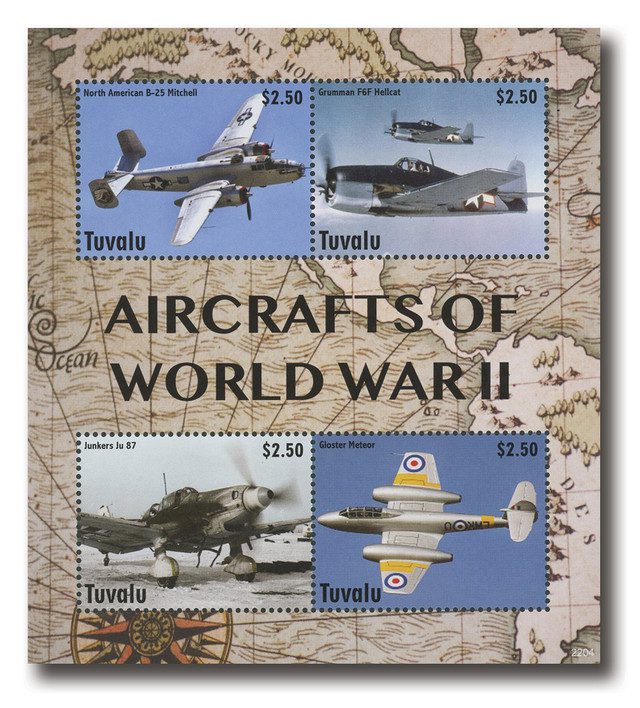On August 19, 1940, the B-25 Mitchell bomber made its first flight. One of the most famous medium bombers of World War II, its combination of speed, durability, and versatility made it a favorite among pilots and ground crews.
Built by North American Aviation, it was named after General Billy Mitchell, a strong advocate of air power who had argued years earlier that aircraft would dominate future wars. The new bomber was designed to be a twin-engine, medium-range plane capable of carrying a decent bomb load while still being agile enough for tactical missions. Its first flight demonstrated that it was fast and reliable, and soon the US Army Air Corps placed large orders. By the time production ended in 1945, more than 9,800 B-25s had been built, making it one of the most produced bombers in history.
One of the most famous moments in the B-25’s service came early in the war: the Doolittle Raid. On April 18, 1942, sixteen B-25s launched from the deck of the aircraft carrier USS Hornet. This was remarkable, since B-25s were not designed for carrier operations. Under the command of Lieutenant Colonel James “Jimmy” Doolittle, the crews bombed Tokyo and other Japanese cities before attempting to land in China. While the raid caused only limited physical damage, its psychological impact was enormous. It proved to Japan that its home islands were not untouchable, and it gave a much-needed morale boost to the American public after the attack on Pearl Harbor.
Beyond the Doolittle Raid, the B-25 served in almost every theater of World War II. In the Pacific, it became a workhorse. Modified versions were equipped with up to eight .50-caliber machine guns in the nose, making them powerful strafing aircraft. These heavily armed B-25s tore through Japanese shipping and ground targets. One famous variant, the B-25H, carried a 75mm cannon—the largest gun ever mounted in an American bomber. While the cannon was difficult to use in practice, the presence of so many guns made the plane deadly against enemy convoys and installations.
In Europe and North Africa, the B-25 was equally valuable. It flew missions over Italy, Sicily, and France, often attacking bridges, supply depots, and airfields. Because of its size, it could operate from shorter runways, making it useful for rapidly advancing Allied forces. The Royal Air Force, the Soviet Air Force, and even the Chinese Air Force all flew the B-25, showing its worldwide impact.
The plane also gained a reputation for being tough. Crews told stories of B-25s returning from missions riddled with holes, missing engines, or with parts of the tail shot away. One famous account describes a B-25 returning safely even after a Japanese fighter sliced off part of its wing during a collision. Its durability saved countless lives.
The Mitchell bomber was not only used in combat. It played a role on the American home front as well. On July 28, 1945, a B-25 on a routine flight in heavy fog tragically crashed into the Empire State Building in New York City. The impact caused major damage to the building and killed 14 people, but the skyscraper itself survived. This incident remains one of the most unusual episodes in the aircraft’s history.
The B-25 stands out as one of the most important aircraft of the war. A total of 9,816 were built in various models between 1940 and 1945. Its maximum speed was about 275 miles per hour, with a range of around 1,300 miles, though this varied depending on bomb load and modifications. The plane could carry about 3,000 pounds of bombs on typical missions, though shorter flights allowed for heavier loads. In terms of armament, depending on the version, a B-25 might carry anywhere from six to eighteen .50-caliber machine guns, making it one of the most heavily armed bombers of its size.
After World War II, the B-25 continued to serve. The US Air Force used it for training, reconnaissance, and transport roles into the early 1950s. Some were even adapted for civilian use as executive transports or firefighting aircraft. Other nations, including Brazil and Indonesia, kept the B-25 in service for years after the war ended. Today, dozens of restored Mitchell bombers are still flying at airshows, serving as reminders of the aircraft’s historic role.
| FREE printable This Day in History album pages Download a PDF of today’s article. Get a binder or other supplies to create your This Day in History album. |
Discover what else happened on This Day in History.







Great that it was named after Billy Mitchell who saw that future wars would use aircraft.
Wow! I didn’t know that one version of the B-25 carried up to 18 50-caliber machine guns. Where on the aircraft where these guns positioned? I’ll have to research this. Thanks, Mystic, for an interesting history.